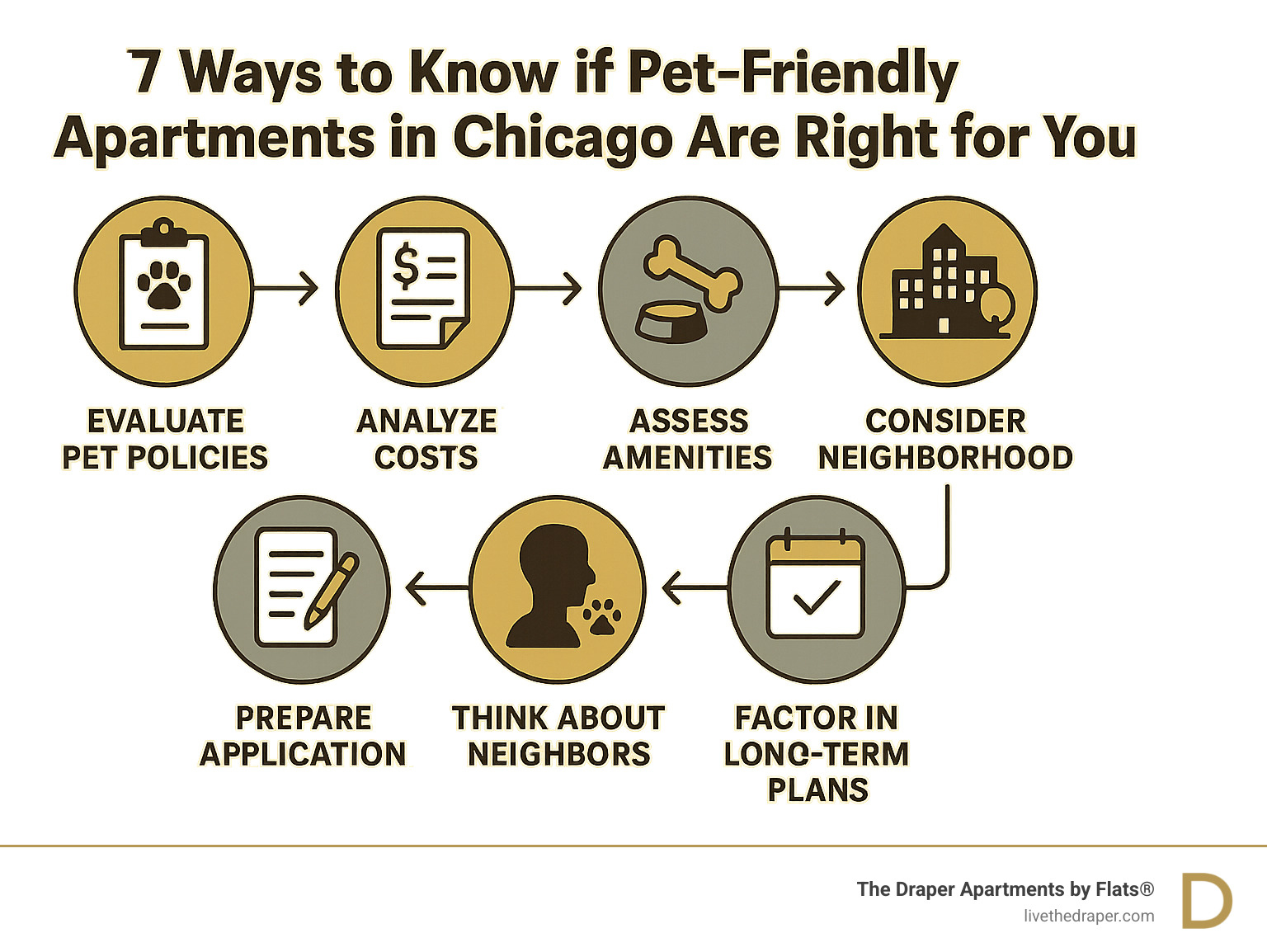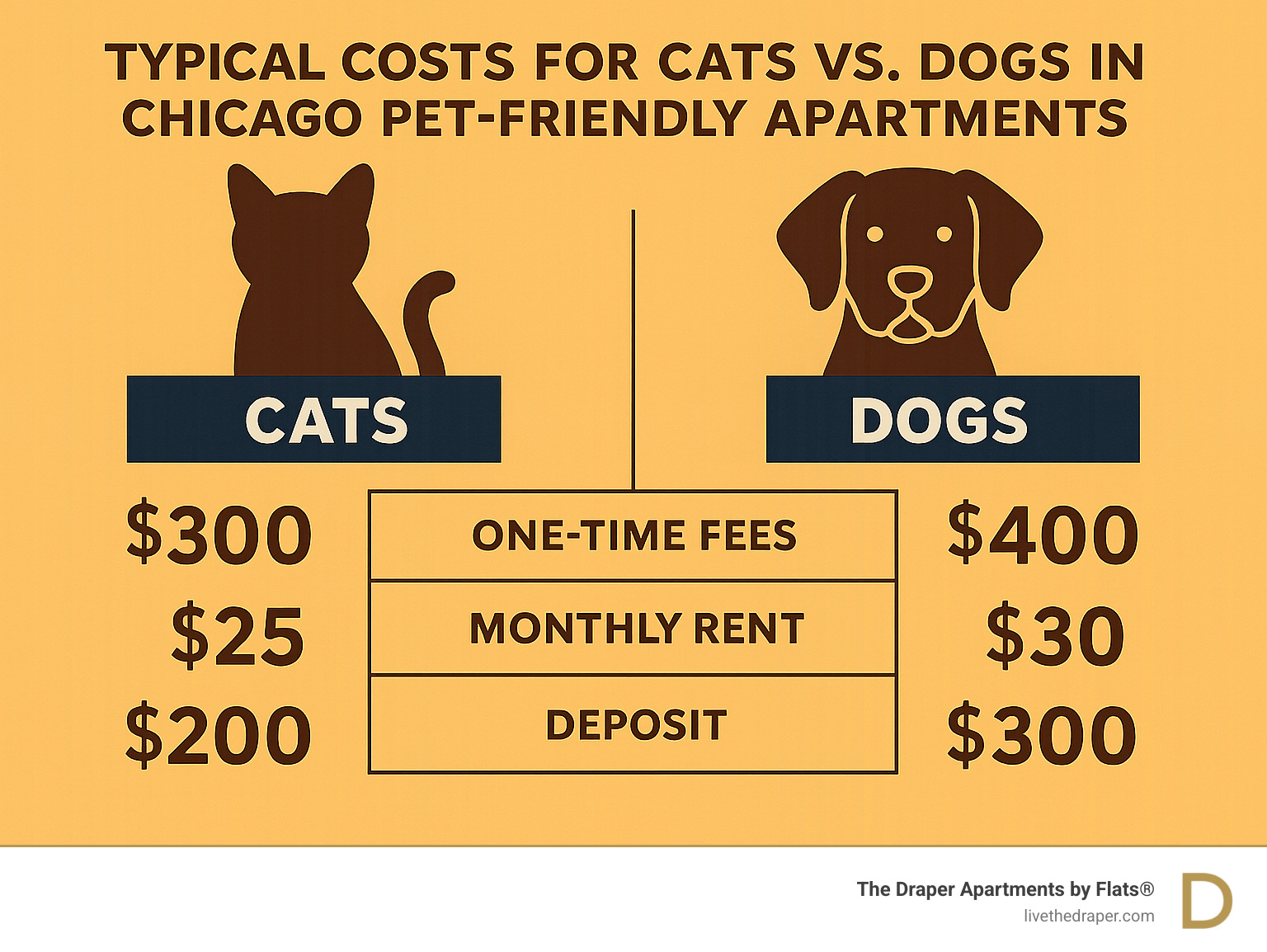Why Finding the Right Pet-Friendly Apartment in Chicago Matters
Pet-friendly apartments chicago offer more than just a "pets allowed" policy - they provide the amenities, policies, and neighborhood features that make city living work for both you and your furry companion. With over 15,000 pet-friendly units currently available across Chicago, the challenge isn't finding options, but finding the right one.
Quick Guide to Pet-Friendly Apartments in Chicago:
- Average pet fees: $300-$400 one-time fee + $25-$30 monthly pet rent
- Common restrictions: 2-pet maximum, breed and weight limits apply
- Best neighborhoods: Lakeview, Uptown, Lincoln Park for walkability and dog parks
- Key amenities to look for: Dog wash stations, on-site runs, waste bag dispensers
- Application essentials: Vet records, pet photos, vaccination proof
Moving with pets in Chicago means navigating breed restrictions (Rottweilers, Pit Bulls, and Dobermans are commonly restricted), understanding the difference between refundable deposits and non-refundable fees, and finding buildings with amenities that actually make your daily routine easier.
The Chicago Park District maintains nearly two dozen designated dog-friendly areas, but proximity to these spaces varies wildly by neighborhood. Some buildings offer dog walking partnerships and 24/7 pet spas, while others simply allow pets without any supporting infrastructure.
This guide breaks down seven key factors to evaluate before signing a lease, helping you avoid surprises and find an apartment where both you and your pet will thrive in the city.

Understand Policies & Costs Upfront
Nobody likes financial surprises, especially when they involve your furry family member. Before you fall in love with that perfect apartment, it's time to dig into the dollars and details that come with pet-friendly apartments chicago.
Here's what you need to know: most buildings allow up to two pets per unit, but the costs can vary wildly from one property to the next. You'll typically encounter a one-time fee plus monthly pet rent, but the devil is definitely in the details.
The biggest mistake renters make? Not understanding the difference between refundable deposits and non-refundable fees. A refundable pet deposit acts like insurance - if Fluffy behaves and doesn't scratch up the hardwood floors, you get that money back when you move out. Non-refundable fees, on the other hand, are gone forever regardless of how angelic your pet is.
Many buildings use a combination approach, charging both a smaller refundable deposit and a non-refundable administrative fee. It's not uncommon to see this split, so always ask which portions of your pet costs you might see again.
Breed restrictions can be the deal-breaker you didn't see coming. Most people expect restrictions on Rottweilers, Doberman Pinschers, and Pit Bull Terriers. But some buildings maintain surprisingly extensive lists that might include breeds you'd never expect to be problematic.
Weight limits add another layer of complexity. A building might welcome a 70-pound Golden Retriever while restricting a 45-pound Siberian Husky based purely on breed perception rather than the individual dog's temperament. Weight restrictions typically range from 25 to 75 pounds, though luxury properties sometimes offer more flexibility.
The two-pet rule is fairly standard across Chicago, but some buildings are stricter while others are more lenient. City ordinances also play a role - Chicago has specific regulations about pet ownership that your lease must comply with.

What does a "pet-friendly apartment" mean in Chicago?
The term "pet-friendly" gets thrown around a lot, but in Chicago's rental market, it has specific meanings that go way beyond just allowing animals through the front door.
A truly pet-friendly apartment includes clear policies about which breeds are welcome, weight limits that make sense, and detailed rules about where your pet can go within the building. Can Rover ride the elevator? Are cats allowed in the lobby? These details matter for your daily routine.
Service animals and emotional support animals operate under different rules entirely. They have legal protections under fair housing laws that standard pets don't enjoy. If you have a service animal or ESA, make sure the leasing office understands the legal distinctions.
For regular pets, every lease should include a pet addendum - a separate document that spells out exactly what's expected of you and your furry friend. This addendum covers everything from which building areas your pet can access to what happens if there's a noise complaint.
The pet addendum isn't just paperwork - it's a legally binding contract that can include provisions for eviction if pets cause damage or create safety issues. Better to understand these terms upfront than find them during a stressful situation later.
Decode the Fine Print in the Lease
Lease clauses about pets often hide requirements that can blindside even careful renters. Beyond the obvious fees and breed restrictions, pet clauses typically address some surprisingly detailed scenarios.
Damage liability clauses make it crystal clear that you're responsible for any damage beyond normal wear and tear. This includes everything from carpet replacement to wall repairs to deep cleaning that goes beyond the standard move-out process. Some leases even include automatic carpet replacement fees, whether your pet actually damaged the flooring or not.
Renewal terms might include annual increases in pet fees or require you to provide updated vaccination records each year. It's worth knowing these requirements ahead of time so you can budget accordingly and keep your vet records organized.
Early termination policies sometimes include additional penalties for pet owners, acknowledging that units with pets typically require more extensive cleaning and preparation for the next tenant.
Here's one that catches people off guard: inspection rights clauses. These allow landlords to conduct additional inspections of units with pets, usually with 24-hour notice. While it might feel intrusive, these inspections actually protect both you and your landlord by catching potential issues before they become expensive problems.
The most important advice? Read every single word of that pet addendum and ask questions about anything that seems unclear. A quick conversation with the leasing office now can prevent months of confusion and conflict down the road.
Evaluate On-Site Amenities That Make Life Easier
When you're touring pet-friendly apartments chicago, the real test isn't just whether they allow pets - it's how well they support your life with them. The best buildings go far beyond basic permission and create spaces that make pet ownership genuinely easier and more enjoyable.
On-site dog runs transform your daily routine, especially during Chicago's unpredictable weather. These secure, fenced areas let your dog exercise and socialize without you having to bundle up for every bathroom break. The thoughtfully designed ones include separate spaces for large and small dogs, plus waste bag stations and fresh water. When the wind chill hits negative twenty, you'll appreciate being able to slip downstairs in your slippers instead of gearing up for arctic conditions.
Dog washing stations might seem like a luxury until you experience them firsthand. Picture this: your golden retriever finds the muddiest puddle in Montrose Beach, and instead of wrestling a soggy, sandy dog into your bathtub, you head to the building's pet spa. Professional-grade tubs with adjustable spray nozzles and paw-washing sinks make cleanup quick and stress-free for both of you.
Some buildings take convenience even further with partnerships with local dog walkers and 24/7 pet spa access. These services become lifelines when work runs late or travel plans pop up unexpectedly. Indoor play areas with agility equipment and climate control mean your energetic pup can burn off steam regardless of what Chicago weather throws at you.
The details matter too. Buildings that install waste bag dispensers throughout common areas and maintain them consistently show they understand pet ownership isn't just about allowing animals - it's about supporting responsible pet parents.
More info about Apartments with Pet Amenities
More info about Apartments with Pet Wash
How Amenities Affect Your Daily Routine
The right amenities don't just add convenience - they completely reshape how you and your pet experience city living. Think about your current routine: how many times do you postpone or rush through pet care because it's complicated or time-consuming?
Time savings become obvious quickly. Instead of scheduling grooming appointments for basic baths or spending twenty minutes cleaning muddy paws in your kitchen sink, you handle it in minutes at the building's wash station. Those minutes add up to hours each month that you get back for yourself.
Weather challenges hit differently when you have backup options. Chicago's winters can make outdoor walks miserable for both you and your pet, but buildings with heated dog runs or covered outdoor areas keep exercise routines consistent. Your dog stays healthier and better behaved when they can maintain their activity level year-round.
The convenience factor extends beyond daily tasks to peace of mind. Knowing you can handle pet emergencies, unexpected messes, or last-minute grooming needs without leaving the building reduces the stress that comes with pet ownership in a busy city.
Hygiene becomes simpler when you have the right tools readily available. No more tracking mud through your apartment or dealing with wet dog smell in your bathroom. Professional washing stations with proper drainage and ventilation handle the messy parts of pet care efficiently.
When you're evaluating pet-friendly apartments chicago, imagine your worst pet-related day - the muddy paws, the unexpected bath needs, the weather that makes walks impossible. The buildings with thoughtful amenities turn those challenging days into minor inconveniences instead of major disruptions.
Pick the Perfect Neighborhood & Outdoor Access

Finding the right neighborhood for your pet can make the difference between daily struggles and effortless trips. Chicago's diverse areas each offer unique benefits for pet owners, and understanding these differences helps you choose a location where both you and your furry friend will truly thrive.
Lakeview has earned its reputation as a pet paradise for good reason. The walkable streets buzz with dog-friendly cafes and shops, while the nearby lakefront provides endless entertainment. Your dog can splash around at Belmont Harbor Dog Beach during warmer months, then warm up at one of the many restaurant patios that welcome four-legged guests.
Uptown strikes a perfect balance between urban energy and outdoor access. The neighborhood puts you minutes away from Montrose Beach and its popular dog area, where your pet can run off-leash and make friends. The Wilson Red Line station makes car-free living totally doable, even when you need to get to the vet across town.
Lincoln Park offers the ultimate combination of green space and city sophistication. With over 1,200 acres of parkland practically at your doorstep, your pet will never lack for exercise options. The neighborhood's upscale buildings often feature those premium pet amenities we talked about earlier.
Don't overlook neighborhoods like Jefferson Park and Morgan Park, which offer more space and often better value for pet-friendly apartments chicago. These areas provide a more relaxed pace while still keeping you connected to the city's veterinary services and pet supply stores.
The Chicago Park District maintains nearly two dozen designated dog-friendly areas across the city, but location matters enormously. Some neighborhoods put three different dog parks within a short walk, while others might require a longer journey for off-leash fun.
Transit access becomes surprisingly important when you're dealing with pet emergencies or regular vet visits. The CTA allows small pets in carriers, but if you have a larger dog, you'll want to think through how you'll handle transportation for those inevitable trips to the animal hospital.
Pet-Friendly Apartments in Jefferson Park Chicago
Pet-Friendly Apartments in Morgan Park Chicago
Matching Your Pet's Lifestyle to a Chicago Neighborhood
Your pet's personality should drive your neighborhood choice just as much as your own preferences. A high-energy Border Collie has very different needs than a senior Basset Hound, and Chicago's neighborhoods cater to these different lifestyles beautifully.
High-energy dogs absolutely love areas like Lakeview and Lincoln Park, where multiple walking routes and dog parks provide endless variety. These neighborhoods offer the social stimulation that active pets crave, with plenty of opportunities to meet other dogs and their owners.
Calmer or older pets often prefer the quieter pace of neighborhoods like Morgan Park, where there's less traffic chaos and more predictable routines. These areas offer a more suburban feel within the city, with easier access to green spaces without the overwhelming hustle and bustle.
Noise sensitivity plays a huge role in pet happiness. Some dogs adapt easily to sirens, construction, and late-night activity, while others become anxious and stressed. Jefferson Park provides urban conveniences with significantly less noise pollution than downtown areas.
Your commute balance affects your pet's quality of life too. A neighborhood that adds an hour to your daily commute means an hour less for walks, playtime, and bonding. Finding that sweet spot between convenience for you and amenities for your pet makes everyone happier.
Consider your pet's social needs as well. Some dogs are natural extroverts who thrive on busy sidewalks and crowded dog parks, while others prefer familiar faces and quieter interactions. Chicago's neighborhood diversity means you can find the perfect match for any personality type.
Nail the Application & Be a Model Neighbor

Getting approved for pet-friendly apartments chicago takes more work than a regular rental application, but the extra effort pays off when you land the perfect place for both you and your furry friend.
Think of your application as telling your pet's story in the best possible light. A well-organized pet resume can make all the difference - include a few great photos that show your pet looking calm and well-groomed, along with basic details like age, breed, weight, and personality traits. Skip the blurry phone shots and go for clear pictures that would make any landlord smile.
Your veterinary records tell landlords that you're a responsible pet owner who stays on top of health care. Most buildings want to see current rabies vaccination records, but having a complete health history shows you're serious about keeping your pet healthy and up-to-date on all care.
References from previous landlords carry enormous weight in the application process. A simple letter stating that your pet never caused damage or noise complaints can overcome a lot of initial hesitation. If you're a first-time renter, references from neighbors, pet sitters, or boarding facilities work well too.
Training certificates from obedience classes show you've invested time and money in your pet's behavior. Even a basic puppy class certificate demonstrates that you take training seriously and aren't just hoping for the best.
Many buildings want to meet your pet in person during the application process. This isn't meant to be stressful - it's actually a great opportunity to show off your pet's best behavior and your skills as a pet parent. Practice basic commands like sit and stay, and make sure your pet is comfortable meeting new people in unfamiliar places.
Chicago, IL Pet Friendly Apartments
Application Hacks for pet-friendly apartments chicago
A few smart strategies can set your application apart from the pile and sometimes even help you negotiate better terms.
Pet insurance documentation shows you're financially prepared for unexpected veterinary bills and potential property damage. Many policies include liability coverage that protects both you and the landlord, which can be especially helpful if your pet falls into a restricted breed category.
Professional photos make a bigger impact than most people realize. A well-lit, clear photo of your pet looking calm and friendly creates a positive first impression before anyone even reads your application. It's worth spending a few minutes to get the lighting right.
Proof of training classes demonstrates your commitment to good behavior, even if your pet is naturally well-behaved. Graduation certificates from puppy kindergarten, basic obedience, or specialty training classes show landlords you're proactive about preventing problems.
Sometimes offering additional security deposit can help overcome breed restrictions or weight limits, especially when combined with strong references and training documentation. This approach works best when you can show that your pet is well-trained despite falling into a category that typically raises concerns.
First impressions during property visits matter tremendously. Bring waste bags, keep your pet on a short leash, and clean up any accidents immediately. These small details show exactly what kind of neighbor you'll be after move-in.
Being a Good Neighbor After Move-In
The real test of pet ownership in apartment living comes after you get the keys. Being thoughtful about how your pet affects other residents makes the difference between a harmonious living situation and ongoing conflicts.
Quiet hours apply to pets just as much as late-night music or television. Barking at 6 AM or running around at midnight creates problems with neighbors faster than almost anything else. Most pets can learn appropriate activity levels for different times of day with consistent training.
Waste cleanup goes beyond just picking up after your pet - it includes proper disposal that doesn't create odors in hallways or common areas. Double-bagging waste and using designated disposal areas shows consideration for everyone who shares the building.
Leash etiquette in elevators, lobbies, and hallways protects both your pet and other residents. Even the friendliest dog can cause problems by approaching someone who's afraid of animals or another pet who isn't social. Keeping control in shared spaces prevents most conflicts before they start.
Common area courtesy includes wiping muddy paws before entering the building, cleaning up any pet hair from furniture in shared spaces, and making sure your pet doesn't mark territory in inappropriate spots. These behaviors become second nature with practice but make a huge difference in how other residents view pet owners.
Regular grooming and health care prevent many neighbor complaints from developing in the first place. A clean, healthy pet is less likely to cause odors or other issues that might affect nearby units. Plus, it shows you take pet ownership seriously, which builds goodwill with both neighbors and building management.
Frequently Asked Questions about pet-friendly apartments chicago
Do pets increase rent prices in Chicago?
Pet-friendly apartments chicago will definitely add to your monthly housing costs, but not always in the way you might expect. The base rent for a pet-friendly unit usually stays the same as similar non-pet units in the building - the extra costs come from additional fees and monthly charges.
Most buildings charge a one-time fee when you move in with your pet, plus ongoing monthly pet rent. These costs vary quite a bit between properties, and some buildings offer flexibility in how you pay. You might find options to pay more upfront with lower monthly costs, or spread the expense out with smaller initial fees and higher monthly payments.
The good news is that pet costs are usually transparent during your apartment search, so you can budget accordingly and compare the total cost of pet ownership across different buildings.
Are there legal protections for renters with pets?
Chicago renters do have some legal protections when it comes to pets, though they're more limited than many people realize. The strongest protections apply to service animals and emotional support animals, which aren't legally considered pets. These animals can't be charged pet fees or restricted based on breed under fair housing laws.
For regular pets, landlords have broad authority to set policies around breeds, numbers, and fees. However, these policies must be applied consistently to all tenants and can't be used to discriminate based on protected characteristics of the renter.
Your best protection comes from having everything clearly spelled out in your lease. A detailed pet addendum that covers all policies, fees, and expectations protects both you and your landlord from future disagreements. Make sure you understand every clause before signing - it's much easier to clarify terms upfront than resolve disputes later.
How many pets can I keep in most Chicago apartments?
The magic number for most pet-friendly apartments chicago is two pets per unit, regardless of whether they're cats, dogs, or one of each. This limit is pretty standard across the city, though you'll find some variation based on building size and apartment square footage.
Luxury buildings sometimes allow more pets, especially in larger units, while smaller buildings or studio apartments might cap you at just one furry friend. The two-pet rule typically counts your total pets combined - so two cats, two dogs, or one cat and one dog would all hit the limit.
Some buildings add extra layers to this policy, like total weight restrictions for all pets combined or requiring individual approval for each pet. A few buildings even have different rules for different unit sizes within the same property.
The key is asking about the specific pet policy during your apartment search rather than assuming the standard two-pet rule applies everywhere. These policies can vary significantly even between buildings on the same block, so it's worth confirming the details before you fall in love with a particular unit.
Conclusion
Finding the perfect pet-friendly apartments chicago comes down to understanding what truly matters for your daily life with your furry companion. After exploring policies, amenities, neighborhoods, and application strategies, you're equipped to make a decision that works for both you and your pet.
The most expensive building with every amenity isn't always the right choice if it's located far from your favorite walking spots or lacks the specific features your pet needs. Similarly, the cheapest option might end up costing more in time and stress if it doesn't provide the conveniences that make city living manageable.
Chicago's rental market rewards pet owners who do their homework. From luxury buildings with professional grooming stations to neighborhood gems with easy park access, the options are abundant. The trick is matching your specific situation - your pet's energy level, your work schedule, your budget, and your lifestyle preferences - to the right combination of location and amenities.
Your decision checklist should include confirming all pet policies in writing, visiting the neighborhood at different times of day to see how it feels, and honestly assessing whether the building's amenities will actually improve your routine. Don't forget to factor in long-term planning - will this apartment work if you adopt another pet, or if your current pet's needs change with age?
The best pet-friendly apartments chicago feel like home from the moment you and your pet walk through the door. When you find that perfect match, you'll know it. Your pet will seem comfortable in the space, the neighborhood will feel right for your daily walks, and the policies will make sense for your situation.
At The Draper Apartments by Flats®, we've designed our community with pet owners in mind, understanding that finding the right home means creating a space where every member of your family can thrive in the heart of Uptown Chicago. Our thoughtful amenities and welcoming atmosphere make the transition to city living smooth for both you and your pet.
Take your time with this decision. Contact leasing teams with your detailed questions, schedule visits during different times of day, and trust your instincts about how each space feels. The right apartment is out there waiting for you and your companion to find it together.









